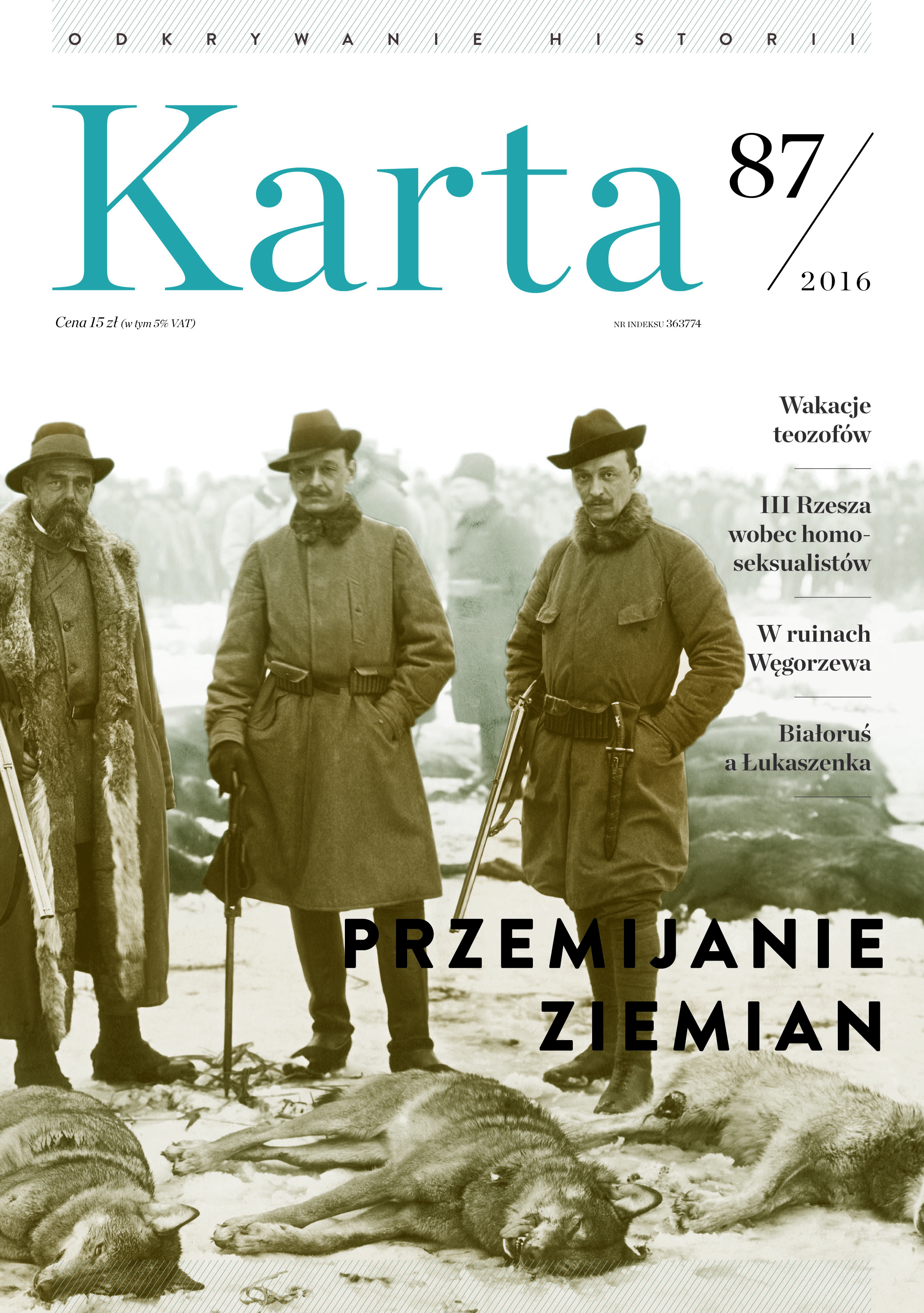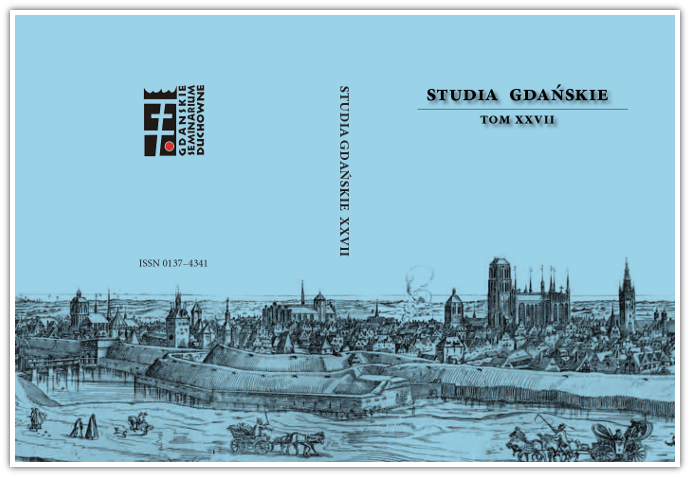


Keywords: teozofowie; teozofia;theosophy
Nad Bugiem, wśród lasów - w miejscu o wyjątkowej urodzie - spędzają swe wakacje teozofowie. Żyjąc blisko natury, lekko traktując społeczne konwenanse i formy, nawiązują silną więź, która opiera się i na wartościach teozoficznych, i na wzajemnej sympatii czy przyjaźni.
More...
Keywords: III Rzesza;Third Reich;homosexual;nazi camps;pink triangle
Pionierska relacja homoseksualisty prześladowanego przez nazistów.
More...
Keywords: oflag; WWII;
Wspomnienia podchorążego, który trafił do niemieckiej niewoli drugiego dnia wojny.
More...
Keywords: PRL;Radio Wolna Europa; Free Europe
Ucieczka przed systemem - od państwa i służb specjalnych (1949-53).
More...
Keywords: Białoruś;Belarus;elections;Lukashenka;
Istota białoruskiej dyktatury z perspektywy kandydata na prezydenta 2010.
More...
Keywords: pogroms;Podlasie;Wąsosz;Radziłów
Domknięcie - głosami z dwóch podlaskich miejscowości - podjętej w "Karcie" 85 i 86 dyskusji wokół zeznań Polaków, którzy latem 1941 mordowali żydowskich sąsiadów.
More...
Keywords: liturgy; Liturgy of Saint James; marian titles.
A Few Considerations on the Marian Titles in the Liturgy of Saint James. The liturgy, as a celebration of our encounter with God in faith, constitutes a fundamental source for the Dogmatic Theology. One of these liturgical sources is the Liturgy of Saint James which was celebrated in the Church of Jerusalem and had a decisive role in the elaboration of the Byzantine liturgies. The aim of my paper is to research this source from a mariological perspective, focusing primarily on the progressive reception of the titles of the Holy Virgin Mary in the Liturgy of Saint James and their meaning. Thus, we shall analyze the marianic titles which can be found in the old sources and in the oldest manuscripts of the text of the Liturgy of Saint James, make the links with the Holy Gospel, with the evolution of the Liturgy of Saint James and present their main dogmatic and spiritual significance.
More...
Keywords: analytical theology; ontological argument; attribute of existence; criteria of existence; empirical evidence; reason; faith; truth; scientific meaning; theological meaning.
This article is primarily an approach to the theological argument from a philosophical and analytical perspective of language. Traditionally and historically, the ontological argument is a logical argument in demonstrating the existence of God. This article emphasizes, on the level of language, a version of theological argument based on mathematical rationality. The nucleus of this paper is given by the relationship between the ontological argument, mathematics and the problem of existence, with new discussions in analytical philosophy and analytical theology. Beyond strictly the “existence” of God, the paper also takes into account the existence of certain theological contents, certain theological attributes, starting not so much from logic, but mathematics. Also, a specific objective of this paper is a comparative presentation of two epistemological problems from the points of view of science and theology: “the epistemological criteria of existence”.
More...
Keywords: Augustine of Hippo; Francesco Petrarca; humanism; biblical intertext; vision; mainspring; monastic literature; secretum meum; Carthusian formation; humanist scholar.
Dialogicity between the Bible, Humanism and the Middle Ages in the Secretum of Francesco Petrarca. While tracing the biblical intertext in Petrarch’s Secretum, a new glimmer seems to illuminate upon the sense of the book. The title echoes medieval monastic texts that clarify the importance of an autobiographical data of the poet; referring to his Carthusian brother’s monastic formation, Petrarch traces the profile of the humanist scholar.
More...
Keywords: Pope Pius XI; Pope Pius XII; Racial laws; Roman law; Vatican; Holocaust; Aryan; Inequality of the races; Jewish question; Encyclical.
The Holy See and the Racial Laws: the Role of Pius XI. This study is focused on the ideological and philosophical development which led to the generation and evolution of Nazi discrimination. Nietzsche philosophy, specifically the idea of Übermensch, paved the way for distortions which reflect the racial ideology at the base of later Nazism. The paper analyses the reaction of the Holy See to the policy of the Italian National Fascist Party.
More...
Keywords: spirituality; devotion; Sacred Heart of Jesus; theology; prayer; Romanian Greek Catholic Church; Romanian Church United with Rome; Greek-Catholic Church; Eastern Churches; Greek Catholicism; spiritual
This study, entitled Devotion to the Sacred Heart of Jesus and the practice of the first Friday of each month in the Romanian Greek-Catholic Church (1918-1948), aims to analyze the practice of this devotion, model specific for Western Roman Catholic Church, in the Romanian Greek-Catholic religious. This paper investigates the determinants of the emergence and taking devotion, chronological period, ways of spreading, the purpose or motivation, Romanian literature review and existing difficulties and objections. The conclusions summarize the results of research.
More...

Keywords: ecology; inculturation; kingdom; missiology; mission without God; poor; values of the Kingdom
More...
Keywords: aesthetics; beauty; liturgical music; music; St. Thomas Aquinas
W szerokiej problematyce, którą podejmował w swych dziełach św. Tomasz z Akwinu odnaleźć można także odniesienia do muzyki, chociaż zagadnienie to nie zostało przez niego opracowane w sposób całościowy. Tomaszową koncepcję muzyki należy rozpatrywać w kontekście jego myśli teologicznej i estetycznej. Dlatego konieczne jest ukazanie najpierw koncepcji piękna, które Akwinata pojmuje jako drogę do spotkania z Bogiem. Na tle jego teorii estetyki, muzyka jawi się jako element cnoty religijności, który realizuje się w liturgii. Wyrazem tego są skomponowane przez św. Tomasza hymny ku czci Najświętszego Sakramentu, które do dnia dzisiejszego obecne są w praktyce liturgicznej Kościoła.
More...
Keywords: christocentrism of the cult of Mary; cult of Our Lady; Kashubia; Kashubia region; people of Kashubia; pieta; pietàs; pilgrimage movement; pilgrimages; representations of Our Lady
Pobożność maryjna i związany z nią kult jest jednym z głównych nurtów, które ożywiają codzienne życie religijne i kulturę Kaszub. Matka Boża jest Królową całego regionu i swoją opieką otacza wszystkich jego mieszkańców. Szczególnym miejscem kultu maryjnego są sanktuaria, które na Kaszubach od lat są ostoją polskości i katolicyzmu. Obserwując życie religijne rdzennych mieszkańców Kaszub można zauważyć, iż sanktuaria maryjne w Sianowie i Swarzewie prezentują wszystkie cechy lokalnego dynamicznego i żywego centrum kultu Matki Bożej. Istotną rolę w oddawaniu czci Maryi odgrywają pielgrzymki do tych sanktuariów, a koronacje figur wpłynęły na ożywienie ruchu pielgrzymkowego. Na uwagę zasługuje chrystocentryzm kultu maryjnego, bowiem uczestnictwo w Eucharystii to kulminacyjny moment uroczystości.
More...
Keywords: Beguines; Burg; Danzig; Dominican nuns; Dominican Order; Kopelcypel; Mantellate; Peter Goldbach; Tertiaries; Toruń
W okresie średniowiecza na terenie Pomorza funkcjonowały dwie wspólnoty tercjarek dominikańskich, mianowicie w Toruniu i Gdańsku. Wpisywały się one w nurt niewielkich miejskich wspólnot religijnych istniejących w XIV‑XVI w: odwiedzały chorych, biednych i więźniów a na swój byt zarabiały pracą ręczną. Ich życie religijne koncentrowało się w wyznaczonej im kaplicy w kościele dominikanów. Siostry zobowiązane były do wspólnych pacierzy i poddane były władzy miejscowego przeora, co stanowiło o ich przynależności zakonnej. Typowe średniowieczne miejskie wspólnoty tercjarek na Pomorzu przetrwały do czasów reformacji, kiedy społeczność Torunia i Gdańska przeszła na protestantyzm.
More...
Keywords: Catholic clergy; Elbląg Lowlands; Malbork Lowlands; Royal Prussia; West Prussia
W 1525 r. przestała istnieć diecezja pomezańska. Dalsze religijne dzieje terenu Żuław i Powiśla związane były z diecezją chełmińską, od 1821 r. z diecezją warmińską, a od 1925 r. także z diecezją gdańską. Artykuł prezentuje uwarunkowania polityczne, duszpasterskie, międzywyznaniowe, obyczajowe i ekonomiczne życia kleru katolickiego na omawianym terenie od XVI w. do zakończenia II wojny światowej.
More...
Keywords: didactic method; faith; methodology; pedagogy; religious instruction and education; school; Władysław Kubik
Dwadzieścia lat katechezy w polskiej szkole jest znakomitą okazją do wspomnień, analiz, podsumowań i wyciągania wniosków na przyszłość. W tej bogatej i wielopłaszczyznowej refleksji nie można pominąć tych, którzy nakreślili w ostatnich dziesięcioleciach kierunki rozwoju polskiej katechezy. Wśród znakomitych katechetyków wyjątkowe miejsce zajmuje ks. prof. Władysław Kubik – najwybitniejszy dydaktyk polskiej katechezy okresu powojennego, niekwestionowany autorytet w tej dziedzinie, pionier w odkrywaniu związków pomiędzy katechetyczną posługą słowa i dydaktyką; nestor polskiej katechetyki, wybitny specjalista w zakresie opracowania podręczników do katechezy i nauki religii.
More...
Keywords: church and state relationship; Orthodox theology; Peter I, Prokopovich
Prokopovich began his ecclesiastical career as a lecturer of the Kiev academy where he taught many subjects and left extensive lecture published posthumously in a multivolume Christianae orthodoxae theologiae. The paper presents some of his views concerning the defense of the authority of the Bible and the need for its literal interpretation; some positive characterizations of God’s attributes; the creation and the makeup of the world; the position of man in the universe; and the problem of eschatology. After Prokopovich was summoned by Peter I to St. Petersburg, he gradually abandoned theology and philosophy and concentrated on political issues and on justification of submitting the church to the power of the state. This culminated in the Spiritual regulation which spelled the end of an independent church in Russia.
More...